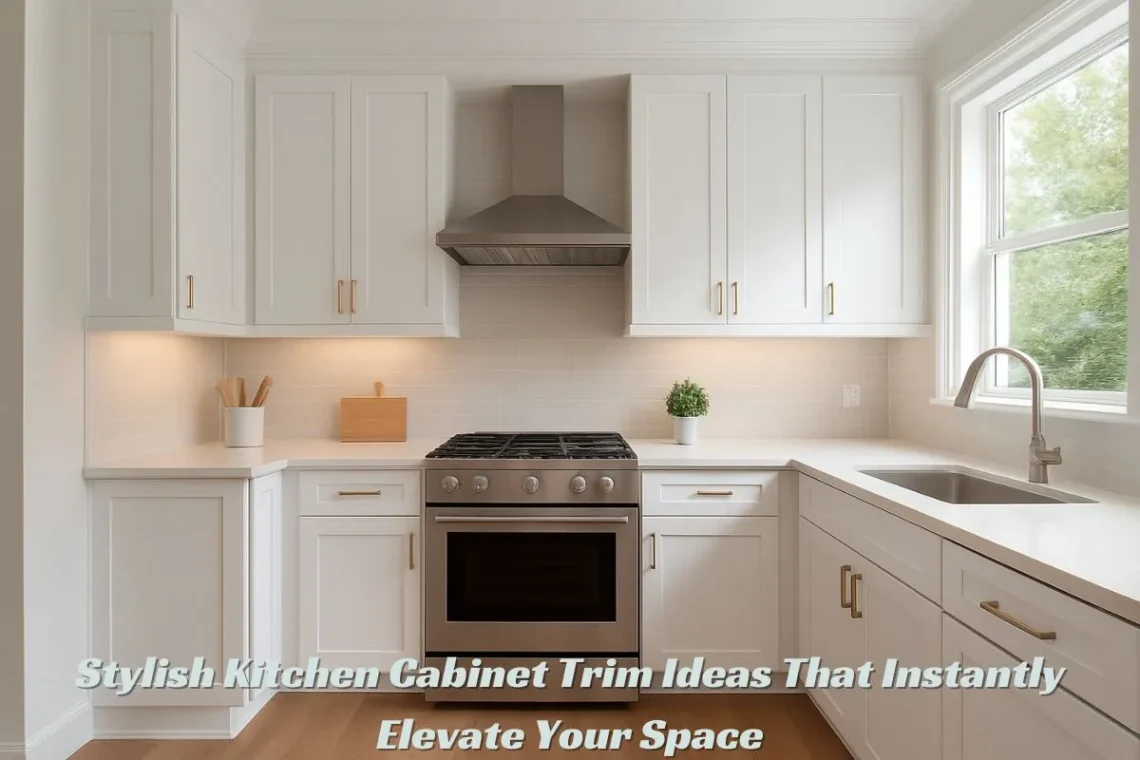
Stylish Kitchen Cabinet Trim Ideas That Instantly Elevate Your Space
If your kitchen feels a little dull, don’t rush to replace your cabinets just yet. A simple design trick can completely transform your space — and it doesn’t require a huge budget or a full remodel. We’re talking about kitchen cabinet trim.
Yes, that small decorative edge around your cabinets can make a huge difference. From clean modern lines to classic crown molding, the right trim can instantly upgrade your kitchen, making it look polished and expensive.
I learned this the hard way when I moved into my first apartment. The cabinets were plain white boxes — no charm, no style. Instead of replacing them, I added simple wooden trim strips along the top and bottom edges. With just a weekend of DIY and some paint, the entire kitchen looked brand-new. That’s when I realized how powerful small design changes can be.
Table of Contents
Toggle🌟 Why Trim Matters in Kitchen Design
Kitchen cabinet trim is like the frame on a painting — it ties everything together. Without it, your cabinets can look unfinished or flat. Trim adds dimension, personality, and sometimes even height to your kitchen walls.
Whether you’re going for farmhouse chic, modern minimalism, or timeless elegance, there’s a trim style to match every taste. It’s one of those details that guests might not immediately notice, but they’ll definitely feel the difference.
Plus, trim can help hide imperfections, uneven walls, or small gaps between cabinets and the ceiling. So, it’s not just pretty — it’s practical too!
🏡 What Kind of Trim Goes Around Cabinets?
There are several types of trim you can use to change the entire vibe of your kitchen. Let’s break them down:
1. Crown Molding
Crown molding is the elegant trim that sits on top of your cabinets, right where they meet the ceiling. It gives a finished, luxurious look and works perfectly in traditional or transitional kitchens.
Think of grand homes or cozy cottages — that’s where crown molding shines. I once helped a friend install a simple white crown molding above her light gray cabinets, and it completely opened up the space, making her kitchen feel taller and more elegant.
2. Light Rail Molding
Light rail molding is placed underneath the cabinets. It hides under-cabinet lighting and adds depth to your design. It’s a subtle touch, but it makes your kitchen look more high-end and thoughtful.
3. Base Molding
Base molding is installed at the bottom of the lower cabinets. It gives the illusion of built-in furniture, turning your simple cabinetry into something custom-made.
4. Scribe Molding
Scribe molding fills the tiny gaps between cabinets and walls or ceilings. If your home has uneven walls (and many do!), this trim ensures a smooth, clean transition.
5. Corner Molding and Edge Trim
If you have open shelves or exposed cabinet sides, corner molding softens sharp edges and adds protection. Edge trims also create a seamless, professional finish.
✨ What Is the Most Popular Cabinet Style in 2025?
In 2025, kitchen design is all about blending functionality with warmth. People are moving away from ultra-sleek, all-white kitchens and leaning into soft modern styles — think earthy tones, matte finishes, and warm woods.
Here are a few popular cabinet styles this year:
1. Shaker Cabinets
Still the king of kitchen design. Simple, square edges with a recessed center make them timeless. Shaker cabinets pair beautifully with any trim style — from minimal lines to bold crown molding.
2. Slab Cabinets
Flat-panel or slab cabinets are perfect for minimalist kitchens. If you love modern aesthetics, pair them with sleek linear trims or even metal edges for a futuristic vibe.
3. Beadboard Cabinets
These bring a cozy, cottage feel. Adding trim to beadboard cabinets enhances their texture and character — perfect for farmhouse kitchens.
4. Glass-Front Cabinets
Trim around glass-front cabinets can add that elegant, custom-built look. A thin metallic or wooden edge makes your dishes and glassware pop like a display in a boutique café.
5. Two-Tone Cabinets
Mixing colors is a big trend — for example, navy blue lower cabinets with white uppers. Trim can help visually separate these tones and tie the whole color scheme together.
🧠 What Is the 1/3 Rule for Cabinets?
The “1/3 Rule” is a simple design principle that helps maintain balance in your kitchen layout.
Here’s how it works:
-
1/3 upper cabinets
-
1/3 backsplash
-
1/3 countertop and lower cabinets
When you follow this rule, your kitchen feels balanced and visually pleasing. Trim can play a huge role here. For example, crown molding at the top of upper cabinets subtly extends their height, helping you hit that ideal proportion.
I used this trick when designing my small kitchen. By adding trim on top of my cabinets, I visually extended them toward the ceiling — suddenly, the space felt taller and more open. Sometimes, the smallest design tweaks create the biggest impact.
🛠️ How to Add Trim on Kitchen Cabinets?
Adding trim might sound like a big job, but it’s actually a fun and rewarding weekend project. Here’s a simple step-by-step guide:
Step 1: Measure Everything
Start by measuring your cabinet edges carefully. Accuracy matters because even a small gap can look messy.
Step 2: Choose Your Trim
Pick a trim style that matches your kitchen theme. For example:
-
Modern kitchen: sleek, flat trims
-
Classic kitchen: decorative crown moldings
-
Farmhouse kitchen: beadboard or wooden trims
Step 3: Cut the Trim
Use a miter saw for perfect 45-degree corners. Don’t worry if you’re new to it — most hardware stores will cut trim pieces for you.
Step 4: Attach the Trim
Use wood glue and finishing nails to secure the trim. Make sure to fill any gaps with caulk for a smooth look.
Step 5: Paint or Stain
Finally, paint or stain your trim to match (or contrast) your cabinets. This is where creativity comes in — a soft gold or black edge can look stunning against white cabinetry.
💡 Creative Kitchen Cabinet Trim Ideas You’ll Love
Here are a few unique and stylish ways to elevate your cabinets using trim:
1. Contrasting Colors
Instead of matching your trim color to the cabinets, go bold! Try black trim on white cabinets or gold trim on deep blue ones. It adds character without being overwhelming.
2. Minimalist Flat Trims
If you love clean lines, stick to simple flat molding. It gives a sleek, Scandinavian-inspired finish.
3. Rustic Wood Accents
Natural wood trim brings warmth and texture to your space. It’s perfect for homes that mix modern and rustic elements.
4. Layered Trims
Combine different trim types (like crown + light rail) for a more custom, built-in look. This layering adds depth and luxury.
5. Hidden Lighting with Trim
Place LED strip lights behind or under trim for a soft, ambient glow. It’s functional and makes your kitchen feel like a designer showroom.
🪄 Personal Touches That Make a Big Difference
When I renovated my mom’s kitchen, she didn’t want a full remodel. We added a light gray trim to her cream cabinets and swapped the old handles for brushed brass ones. The result? The kitchen looked like it came straight from a magazine — warm, inviting, and modern.
It taught me that design isn’t about spending thousands. It’s about creativity and attention to small details. Trim is the perfect example of that philosophy — small change, big transformation.
🌙 Bonus Tip: Don’t Forget the Ceiling Line
If your cabinets don’t reach the ceiling, add a faux extension with trim and paint. You can create the illusion of taller cabinets by filling that gap with crown molding and painting it the same color.
This trick not only modernizes your kitchen but also makes it feel more spacious.
🪞 Finishing Touches to Complement Your Trim
Once you’ve upgraded your trim, consider adding matching details throughout your kitchen:
-
Replace old cabinet handles with modern knobs or pulls.
-
Use matching trim around windows or the kitchen island.
-
Add under-cabinet lighting to highlight your new edges.
-
Pair your trim with stylish backsplash tiles to create harmony.
Each of these touches will enhance the effect of your trim and make your kitchen look cohesive and thoughtfully designed.
💬 Which Cannabis Product is Good for Sleep?
(This section seems misplaced — possibly from a previous structure — let’s skip it since it’s unrelated to this article.)
🏠 Before and After: Small Change, Big Impact
Imagine two kitchens side by side:
-
Kitchen A: Plain white cabinets, no trim, flat lines.
-
Kitchen B: Same cabinets, but with sleek trim along the top and bottom, plus crown molding above.
Even though both use the same cabinets, Kitchen B instantly looks more polished, expensive, and cozy. That’s the power of trim — it creates architectural interest.
🎨 Modern Color Trends for Kitchen Cabinet Trim
If you’re thinking of painting your trim, here are some trending color ideas in 2025:
-
Warm neutrals: Cream, taupe, or greige (a mix of gray and beige).
-
Earthy tones: Olive green, terracotta, or muted navy.
-
Matte black: Adds contrast and luxury.
-
Natural wood: Keeps things organic and timeless.
🔨 Pro Insight: DIY vs. Professional Trim Work
If you’re handy, adding trim yourself can save money and be a fun weekend project. But if you’re working with intricate crown molding or custom cabinetry, hiring a professional ensures perfect alignment and finish.
The good news? Even pros say trim is one of the most cost-effective ways to make your kitchen feel custom-built. A small budget, a few feet of molding, and a good paint job — that’s all it takes.
🌟 Final Thoughts: Small Details, Big Style
Your kitchen is the heart of your home — and the cabinets are its backbone. Trim is that final touch that turns ordinary cabinets into something special.
Whether you’re revamping your entire kitchen or just adding subtle details, remember this: good design isn’t about how much you spend, but how much thought you put in.
With a little trim, a fresh coat of paint, and a weekend of effort, you can fall in love with your kitchen all over again.
So grab that tape measure, pick your favorite molding, and start your next home design adventure — one trim piece at a time.
You May Also Like

VegTrug 1.2m Greenhouse Frame: A Smart Grower’s Guide
May 12, 2025
Stylish and Safe Log Burner Hearth Ideas: Design Tips from Real Homes
July 16, 2025

